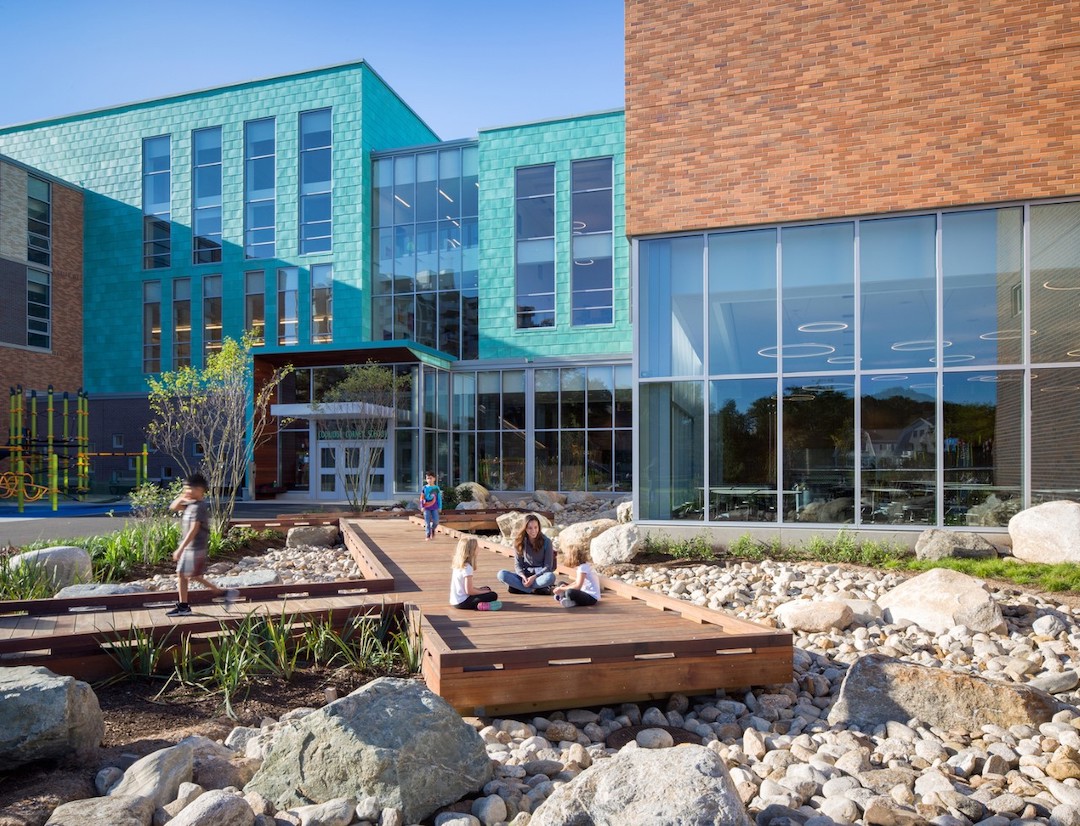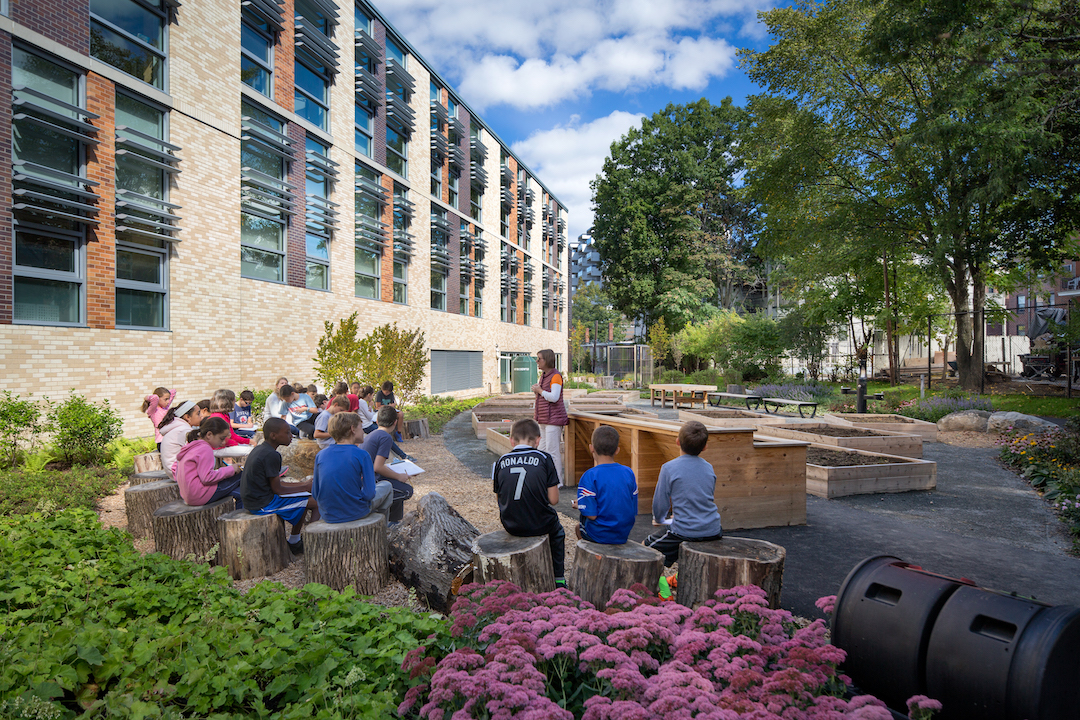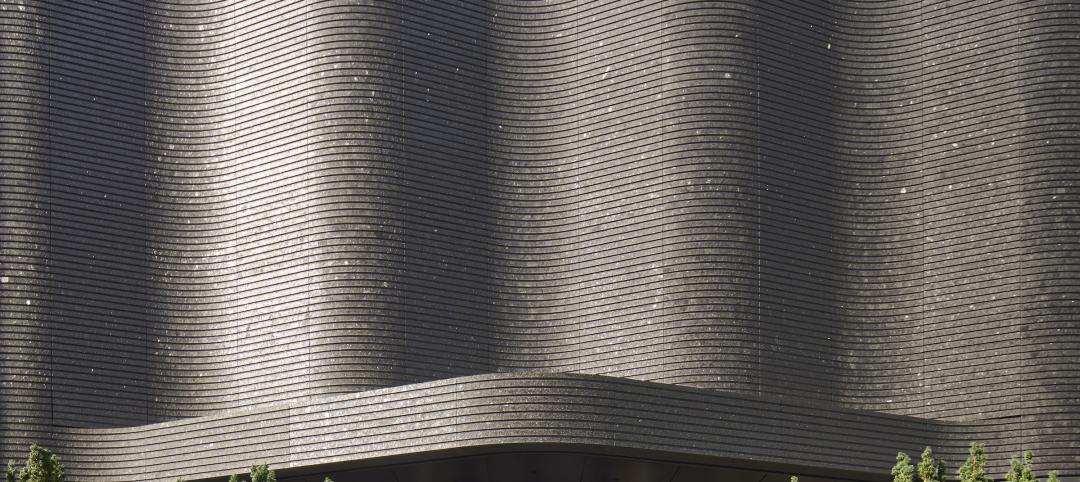The nation’s school districts are focused on providing well-rounded learning experiences that plant seeds for future vocations in science, technology, business, or skilled trades.
In New Hampshire, the new Dover High School and Regional Career Technical Center brings together 1,500 students in a combined 302,000-sf facility.
“Parents and educators recognized the importance of making sure the career technical students were exposed to the highest academic standards possible, and that the traditional students had more involvement in hands-on programs and activities,” says Laura Wernick, FAIA, REFP, LEED AP, Senior Principal, HMFH Architects, Cambridge, Mass. “The high-bay spaces are integrated with traditional academic spaces, so a science classroom might be next to an automotive lab.”
School districts are continuing to shift their focus toward STEM and STEAM learning. NeoCity Academy, a new 500-student public STEM magnet high school in Kissimmee, Fla., will open in August. Located in a 500-acre technology district, the net-zero energy facility will expose students to an engineering, biomedical, and cyber security curriculum in immersive, flexible learning environments. Many of the school’s instructors will come from the University of Central Florida and the Florida Advanced Manufacturing Research Center.
ALSO SEE: Top 140 K-12 Sector Architecture Firms
ALSO SEE: Top 75 K-12 Sector Engineering Firms
ALSO SEE: Top 90 K-12 Sector Construction Firms
Gould Evans and DLR Group collaborated on the design of the Missouri Innovation Campus in Lee’s Summit, Mo. The STEM-focused facility unites 600 high schoolers and 1,200 University of Central Missouri students in a shared campus that enables high school graduates to earn associate and bachelor degrees.
Elementary schools are also embracing new learning environments. At Centerview Elementary School, a new K-4 school in Spring Lake Park, Minn., flexible learning studios include spaces for group learning, active learning, STEM, and specialized learning.
Outdoor classrooms, a rain garden, school gardens, and natural play elements are integral learning elements at Coolidge Corner School, an urban pre-K-8 school in Brookline, Mass. “Varied outdoor environments can play an important role in a student’s social and emotional development,” says Pip Lewis, Principal, HMFH Architects.
OVERCOMING FUNDING LIMITATIONS at school districts
Some school districts are circumventing funding obstacles through creative renovation projects, says Steven Herr, AIA, Director of Design, Fanning Howey, Indianapolis. “An old elementary school can become an innovation campus. A spirit shop can become a business incubator lab,” he says. Schools are becoming more diligent in identifying and repurposing underused space for a modern use.
In Hilliard, Ohio, a suburb of Columbus, Fanning Howey oversaw the transformation of a traditional K-6 into a new innovation campus, all without moving a single wall. The Hilliard Innovative Learning Hub, which serves grades 6-12, provides experiences not available elsewhere in the district, such as a new Design Thinking course that incorporates language arts, science, and public speaking.
Public referendums are no longer the obvious go-to strategy for funding K-12 construction. “More states are going to need to pursue alternative methods to fund projects that won’t require voter approval,” such as private partnerships offered as tax credits and tax-direct incentives to districts, says Vaughn Dierks, AIA, LEED AP, Partner, Wold Architects and Engineers, Saint Paul, Minn.
 Coolidge Corner School, Brookline, Mass. Photo: HMFH Architects / Ed Wonsek
Coolidge Corner School, Brookline, Mass. Photo: HMFH Architects / Ed Wonsek
Many rural and smaller communities can’t afford to make even basic investments in maintenance and infrastructure. In Colorado, the BEST (Building Excellent Schools Today) grant program allocates a portion of state revenue to fund school facilities in need, particularly in small districts. “This is one way states are making safe, modern, effective teaching environments accessible to all students,” says Dierks.
The Texas legislature is considering a $9 billion plan, including property tax reform, to fund the state’s public schools. “This is a heated topic,” says Angela Cardwell, Chief Marketing Officer, Joeris General Contractors, San Antonio. “While funding for construction comes from bonds and not from the same pool of money as allocated by the state legislature, any reform will impact the overall state of school spending.”
Wold’s Dierks says school districts can use maintenance projects as a means to achieve broader goals. Edina, Minn., is studying how to use roof replacements as an opportunity to partner with third-party solar panel providers to maximize life cycle benefits and minimize costs, he says. The Minneapolis Public Schools system is using the renovation of outdated restrooms and locker rooms as an opening to set new practices for personal comfort and safety amid questions of gender identity, equity, and privacy.
Some K-12 schools are expanding their core educational mission to provide broader social and human service functions for students and communities. Last March, Mayo Clinic opened a health clinic at the Alternative Learning Center, a nontraditional school in Rochester, Minn., where about two-thirds of students qualify for free or reduced-price lunches. The new clinic provides acute and chronic medical care to students and their dependents; payment is adjusted according to ability to pay. Other onsite conveniences provide homeless students with daycare, showers, laundry facilities, and clothing and food shelves. (More K-12 school building news and trends.)
MORE FROM BD+C'S 2019 GIANTS 300 REPORT
Related Stories
Data Centers | Sep 21, 2023
North American data center construction rises 25% to record high in first half of 2023, driven by growth of artificial intelligence
CBRE’s latest North American Data Center Trends Report found there is 2,287.6 megawatts (MW) of data center supply currently under construction in primary markets, reaching a new all-time high with more than 70% already preleased.
Giants 400 | Sep 20, 2023
Top 130 Hospitality Facility Architecture Firms for 2023
Gensler, WATG, HKS, and JCJ Architecture top BD+C's ranking of the nation's largest hospitality facilities sector architecture and architecture/engineering (AE) firms for 2023, as reported in Building Design+Construction's 2023 Giants 400 Report. Note: This ranking includes revenue for all hospitality facilities work, including casinos, hotels, and resorts.
Adaptive Reuse | Sep 19, 2023
Transforming shopping malls into 21st century neighborhoods
As we reimagine the antiquated shopping mall, Marc Asnis, AICP, Associate, Perkins&Will, details four first steps to consider.
Giants 400 | Sep 18, 2023
Top 200 Office Building Architecture Firms for 2023
Gensler, Stantec, HOK, and Interior Architects top BD+C's ranking of the nation's largest office building sector architecture and architecture/engineering (AE) firms for 2023, as reported in Building Design+Construction's 2023 Giants 400 Report. Note: This ranking includes revenue for all office building work, including core and shell projects and workplace/interior fitouts.
Resort Design | Sep 18, 2023
Luxury resort provides new housing community for its employees
The Wisteria community will feature a slew of exclusive amenities, including a market, pub, and fitness center, in addition to 33 new patio homes.
Life of an Architect Podcast | Sep 18, 2023
Life of an Architect Podcast Ep. 134: Management 101
It happens to most people eventually. Some get there quickly, while others take a bit longer. Transitioning into a management role is a natural evolution of skill development, but that doesn’t necessarily make it any easier. Chances are you’re ready for management, but in case you’ve questions, we think we have answers.
Hotel Facilities | Sep 15, 2023
The next phase of sustainability in luxury hotels
The luxury hotel market has seen an increase in green-minded guests looking for opportunities to support businesses that are conscientious of the environment.
Adaptive Reuse | Sep 15, 2023
Salt Lake City’s Frank E. Moss U.S. Courthouse will transform into a modern workplace for federal agencies
In downtown Salt Lake City, the Frank E. Moss U.S. Courthouse is being transformed into a modern workplace for about a dozen federal agencies. By providing offices for agencies previously housed elsewhere, the adaptive reuse project is expected to realize an annual savings for the federal government of up to $6 million in lease costs.
Data Centers | Sep 15, 2023
Power constraints are restricting data center market growth
There is record global demand for new data centers, but availability of power is hampering market growth. That’s one of the key findings from a new CBRE report: Global Data Center Trends 2023.
Engineers | Sep 15, 2023
NIST investigation of Champlain Towers South collapse indicates no sinkhole
Investigators from the National Institute of Standards and Technology (NIST) say they have found no evidence of underground voids on the site of the Champlain Towers South collapse, according to a new NIST report. The team of investigators have studied the site’s subsurface conditions to determine if sinkholes or excessive settling of the pile foundations might have caused the collapse.

















